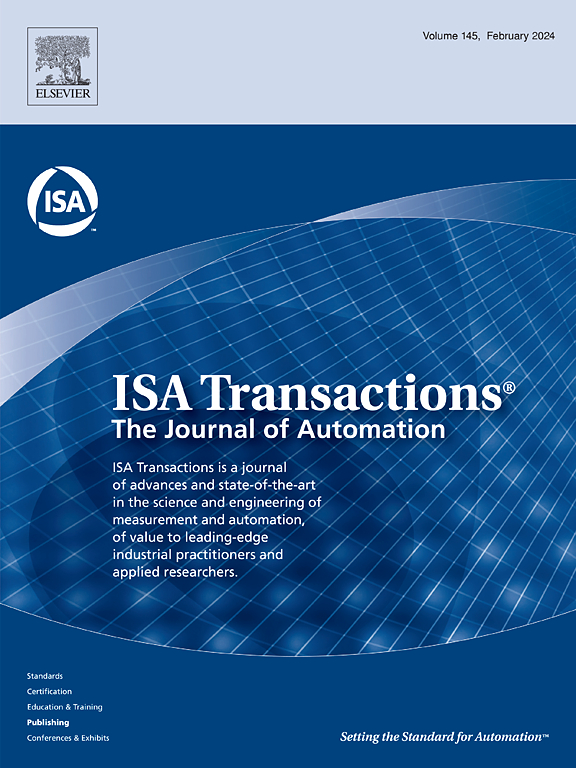Estimation of remaining useful life (RUL) for pneumatic actuator without apriori RUL history: A hybrid prognostic approach
IF 6.3
2区 计算机科学
Q1 AUTOMATION & CONTROL SYSTEMS
引用次数: 0
Abstract
Predicting the Remaining Useful Life (RUL) of an industrial pneumatic actuator is crucial for enhancing maintenance strategies, reducing downtime and optimizing resource allocation. However, estimation becomes challenging when no historical RUL data is available for modeling. In this paper, a novel hybrid prognostic approach that combines Dynamic Time Warping (DTW), Exponential Degradation Model (EDM) and Random Forest Regressor (RFR) is proposed to estimate the RUL of pneumatic actuators under the absence of apriori RUL history. The DTW technique is employed to identify the onset of potential degradation. By aligning the healthy and faulty data, DTW provides a robust measure of distance and time at the point of deviation as the threshold value. Subsequently, the EDM is introduced to capture the degradation pattern in the actuator behavior. The EDM accounts for the relationship between threshold value, operating conditions, degradation rate and exponential coefficients through curve fitting methods. To further enhance prediction accuracy, RFR is employed to predict the RUL based on input features of aligned data from DTW and the derived degradation rates from EDM. In the simulation studies, the proposed methodology is applied to a synthetic dataset and benchmark DAMADICS dataset of the industrial pneumatic actuator in sugar processing unit to estimate RUL. The estimated RUL for each health indicator is quantified and the severity of each fault is discussed. The proposed method is implemented on a real time laboratory setup. The results are also validated on the benchmark NASA turbo-engine dataset by comparing the actual and estimated RULs, achieving 82.5 % range-based accuracy.
无先验RUL历史的气动执行器剩余使用寿命(RUL)的估计:一种混合预测方法。
预测工业气动执行器的剩余使用寿命(RUL)对于加强维护策略,减少停机时间和优化资源分配至关重要。然而,当没有可用于建模的历史规则数据时,估计就变得具有挑战性。本文提出了一种结合动态时间扭曲(DTW)、指数退化模型(EDM)和随机森林回归(RFR)的混合预测方法,用于在没有先验RUL历史的情况下估计气动执行器的RUL。DTW技术用于识别潜在降解的开始。通过对齐健康数据和故障数据,DTW提供了在偏差点处的距离和时间的可靠度量,作为阈值。随后,引入电火花加工来捕获致动器行为中的退化模式。电火花加工通过曲线拟合的方法来解释阈值、工况、降解率和指数系数之间的关系。为了进一步提高预测精度,基于DTW对齐数据的输入特征和EDM导出的退化率,采用RFR方法对RUL进行预测。在仿真研究中,将提出的方法应用于制糖装置工业气动执行器的合成数据集和基准DAMADICS数据集来估计RUL。对每个健康指标的估计RUL进行了量化,并讨论了每个故障的严重程度。该方法在一个实时实验室装置上实现。结果还在NASA涡轮发动机基准数据集上进行了验证,通过比较实际和估计的rul,达到了82.5%的基于距离的精度。
本文章由计算机程序翻译,如有差异,请以英文原文为准。
求助全文
约1分钟内获得全文
求助全文
来源期刊

ISA transactions
工程技术-工程:综合
CiteScore
11.70
自引率
12.30%
发文量
824
审稿时长
4.4 months
期刊介绍:
ISA Transactions serves as a platform for showcasing advancements in measurement and automation, catering to both industrial practitioners and applied researchers. It covers a wide array of topics within measurement, including sensors, signal processing, data analysis, and fault detection, supported by techniques such as artificial intelligence and communication systems. Automation topics encompass control strategies, modelling, system reliability, and maintenance, alongside optimization and human-machine interaction. The journal targets research and development professionals in control systems, process instrumentation, and automation from academia and industry.
 求助内容:
求助内容: 应助结果提醒方式:
应助结果提醒方式:


